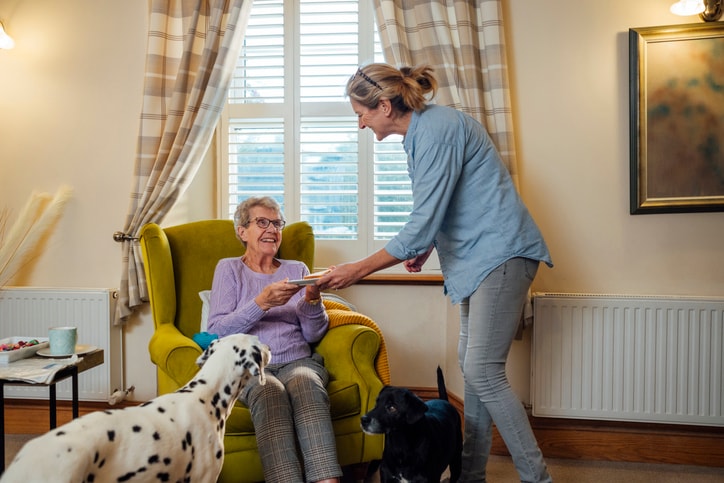In order to figure out the ideal living situation for yourself or an older loved one, a senior living assessment needs to be conducted. In addition to determining the most appropriate services for older adults, a senior care assessment can zero in on the best living situation — independent living, assisted living, home care, etc.
“A senior living assessment is a way to get a clear understanding of what an older adult needs,” explains Kristine McGinn, co-founder of Assurance Home Care. “The assessment helps ensure they’re receiving the right level of care by looking at things like physical health, mobility, memory and more.”
From what to expect to how to prepare, here’s expert insight on senior living assessments.
What is a senior living assessment?
As the name suggests, a senior living assessment is a comprehensive evaluation in order to determine what healthcare needs and services are most appropriate, along with what healthcare setting is most appropriate, explains Josie Rhoades, vice president of clinical operations at BrightStar Care.
It may look different, depending on where and why they’re conducted. For instance, if an older adult is set to move into assisted living, an assisted living assessment would be conducted, taking into account what particular services would be needed at the facility. When you’re starting from square one, however, a general senior living assessment is in order.
Assessments may take things such as overall health, fall risk and medication protocol into account, Rhoades notes, and the information is then used to create “a plan of care for services or validate the most appropriate living setting.”
Who conducts a senior living assessment?
The assessments are always completed by trained professionals who specialize in understanding the unique needs of older adults, McGinn notes; however, depending on the needs, facility or location, the professional conducting the senior living assessment can vary.
“Nurses, social workers and/or geriatric care managers are often responsible for evaluations,” McGinn explains. “Sometimes, home care agencies have staff trained specifically to help with this kind of evaluation. Whoever it is, they’ll guide you through the process, make recommendations and help you figure out the best options based on what you or your loved one needs.
Components of a senior living assessment
According to McGinn, senior living assessments are a combination of questions and some physical evaluations. “They might ask about health, medications, any issues with getting around or if you or your loved one is having trouble with certain tasks,” she says.
Additionally, the facilitator may check out the living space to make sure it’s safe and see if any changes are needed.
Here’s a quick breakdown of what a senior living assessment may look like, per Rhoades.
- Physical/health assessment. This, Rhoades notes, is the collection of objective and subjective information. Physical assessments can include interviewing clients, their families and/or caregivers to gain knowledge about their health history and diagnoses.
- Fall risk assessment. An evaluation to determine how likely it is for an older adult to fall, this portion is often questions that help to identify potential risks to avoid/mitigate potential falls.
- Functional assessment. “This not only includes evaluating the patient’s functional abilities and their physical and mental capacity to perform Activities of Daily Living (ADLs), Instrumental Activities of Daily Living (IADLs) and the safe use of Durable Medical Equipment (DME),” Rhoades notes, “it also includes the assessments of pain, oxygen, nutritional and environmental statuses.
- Home environmental assessments. These are used to identify safety risks in the home, assisted living facility or community environments, including mobility barriers and potential fall hazards.
- Psychosocial assessment. This entails evaluating cognitive, developmental and behavioral abilities by “testing their coping strategies with anxiety, depression and abuse and neglect screening,” explains Rhoades. This may also help identify family and support systems and spiritual needs including cultural and religious factors, as well as the client’s level of education.
- Socioeconomic assessment. A review of the financial status, as well as the available resources and benefits.
- Medication assessment. This portion, Rhoades notes, may be referred to as “medication reconciliations or evaluations.” It involves comparing the patient’s list of medications with the medications present in their home. “Current prescription medications and over-the-counter medications are evaluated with a review of the patient’s medication history, any medication allergies, sensitivities or adverse reactions and the patient’s compliance in consuming the medications,” she adds. In other words: Are they on top of their medication management and doctor orders?
What to expect from a senior living assessment
While you or your loved one may be asked to perform certain tasks, it’s “more of a conversation than anything else,” McGinn notes, adding that the goal is to get a firm understanding of the client and improve — not completely revamp — their living situation.
That said, do keep in mind that the evaluation can be long — between one and two hours — and the questions “can be personal in nature,” adds Rhoades.
How to prepare for a senior living assessment
Both McGinn and Rhoades agree that one of the best ways to prepare for a senior living assessment is to gather any important medical information and medications, so you have them at the ready.
Additionally, make sure to invite pertinent family members or caregivers to the assessment, and write down any questions or concerns in advance, including the preferred timeline in which you hope to bring in help or find an updated living situation.
“This way,” notes McGinn, “the person doing the assessment can really tailor the care plan to fit your needs and preferences.”
The bottom line
Senior living assessments can feel like a lot, but the ultimate goal is to determine the best, most supportive living situation, explains McGinn. “In the end, it’s all about coming up with a plan that fits a person’s lifestyle and unique needs.”





